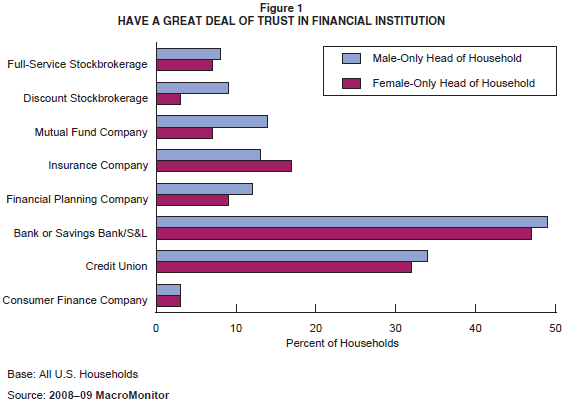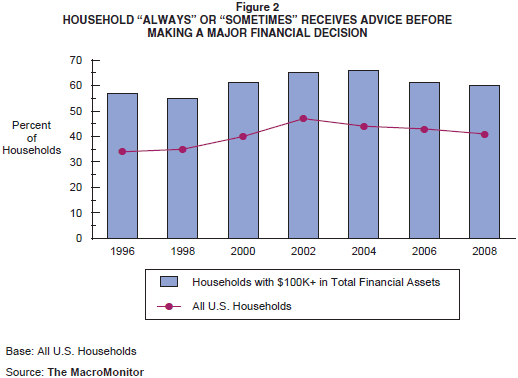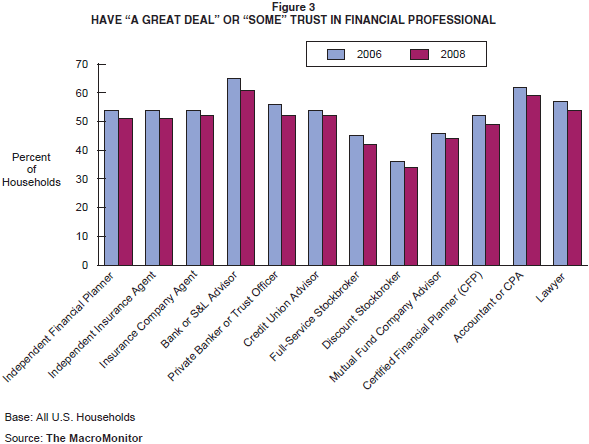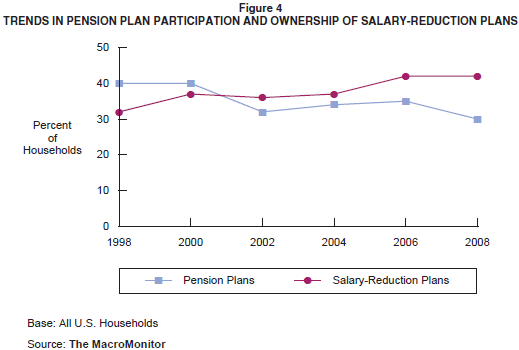MacroMonitor Market Trends January 2009
MacroMonitor Market Trends highlights topical news and trends of interest to you and your colleagues. If you would like more information about the items in the newsletter or would like to discuss other ways that we can assist you in your research and marketing efforts, please contact us.
In this issue:
Winning Back Women's Trust Will Be a Challenge
Faced with bank failures, sinking stock market and retirement-fund valuations, and a high-profile investment scandal, many U.S. households—not surprisingly—have lost trust in financial institutions across the board. Although gaining back the trust of all households is sure to be a challenge for most institutions, our 2008–09 MacroMonitor data indicate that winning back women's trust may be particularly difficult. Even before the September 2008 financial crisis, women financial decision makers were significantly more skeptical of almost every type of financial institution than were their male counterparts. As Figure 1 indicates, in a comparison of trust in types of institutions, although the highest percentages of female-only and male-only heads of households trust banks and S&Ls a great deal, a slightly smaller percentage of the women than of the men do so. Meanwhile, substantial differences exist between the sexes in their high level of trust in discount brokerages and mutual fund companies. In 2008, discount brokerages garner a great deal of trust from 9% of male-only heads of household but from just 3% of female-only heads; 14% of men and just 7% of women have a great deal of trust in mutual fund companies. Insurance companies are the only type of institution to which a higher percentage of women than men accord the highest level of trust: 17% of female-only households and just 13% of male-only households have a great deal of trust in this financial provider.
The trust that female-only heads have in insurance companies reflects women's financially conservative nature. MacroMonitor data have shown that women have a lower risk tolerance than men have and tend to favor safer, savings-oriented products over high-risk, high-return products. In 2008, for example, 58% of female-only heads of household—in comparison with only 48% of male-only heads of household—agree that the stock market is too risky for them. Women more than men tend to prefer financial simplicity. Six in ten female-only heads of household mostly agree that they like to keep their financial affairs uncomplicated, in comparison with just 54% of male-only heads; 43% of the female-only heads would like to go to just one person for their saving, investment, and credit needs, versus merely 34% of the male-only heads who would like to do so.
Because women financial decision makers make up more than one-third of the financial-consumer market base, marketers must factor into consideration the marked differences in financial attitudes and preferences between men and women. During the current uncertain economic times, regaining and subsequently maintaining the trust of this substantial but skeptical financial bloc is crucial to financial institutions' success. Financial providers who emphasize the safety of their institutions and products and who provide simple and personal products, services, and advice are likely to find a more receptive market among women.

Surprisingly, Households' Use of Advice Remains Relatively Flat in 2008
The 2008–09 MacroMonitor shows that 41% of U.S. households "always" or "sometimes" receive advice before making major financial decisions. This incidence is down slightly from 43% of households in 2006. Typically, consumers' use of financial advice correlates with a down economy. However, it is usually a lagging indicator. Because we fielded the 2008–09 MacroMonitor in the spring and summer of 2008—during a down market but before complete disaster struck—we expect that current market circumstances will have consumers flocking for advice.

One possible hurdle for advisors, though, is consumers' heightened mistrust of financial institutions and their advice. The ability of financial institutions and their personnel to manage consumers' money has sustained severe tarnish in the past six months. The 2008–09 MacroMonitor shows that households' level of trust in advisors had already declined from previous years before the crisis hit in September and more than likely has fallen even more since.
Those institutions and advisors that consumers perceive as trustworthy and those promoting an emphasis on risk management will be in the best position in the current environment. Although aggregate assets under management certainly have shrunk, advisors have a clear opportunity: Consumers have an increased need for guidance in making wise financial decisions and for help in figuring out how they are going to do more with less

Pension Plans Decline as Salary-Reduction Plans Increase
During the past decades, many employers have cut benefits from the packages they offer employees. In light of higher health-care costs, some employers, having to manage pension assets in volatile investment markets and having to pay higher wages to maintain competitiveness in the labor market, have had to cut back on retirement benefits, most notably on defined-benefit pension plans. As Figure 4 depicts, participation in pension plans has been on a steady decline in recent years. MacroMonitor data show that during the past decade, the percentage of households covered by a pension plan has dropped by 25%, from 40% of all households in 1998 to only 30% in 2008.
Apparently, however, all is not lost. Because fewer employers now offer defined-benefit pension plans, employees are increasingly turning to salary-reduction plans (SRPs) such as 401(k)s, Roth 401(k)s, 403(b)s, and 457s plans to gain control of their retirement savings. As Figure 4 portrays, the growth in SRPs in the past decade has more than offset the decline in pension plans: Ownership of SRPs grew by 31%; coverage by a pension plan fell by 25%. The percentage of households owning an SRP increased from 32% of all households in 1998 to 42% in 2008. This growth in salary-reduction plans should be encouraging to financial-services providers because SRPs force consumers to engage more in their household's retirement planning. The 2008–09 MacroMonitor data indicate that for two out of three households, providing for retirement is a specific goal for their savings and investments. Thus, even during tough economic times, consumers are continuing to think about and save for their retirement.
